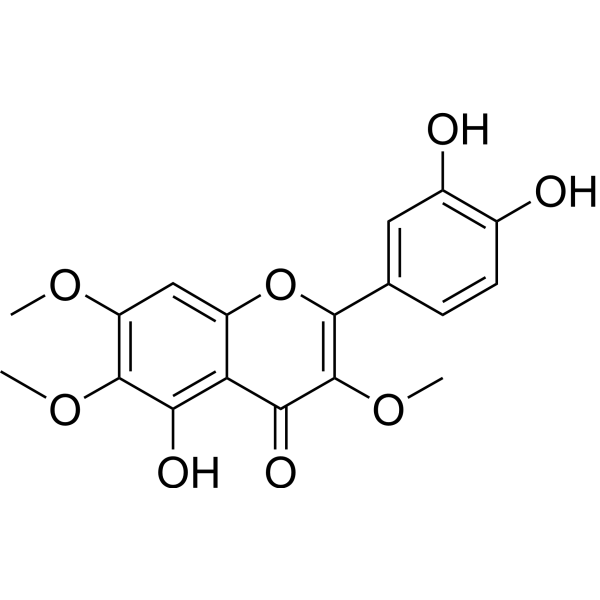Physicochemical Properties
| Molecular Formula | C18H16O8 |
| Molecular Weight | 360.31 |
| Exact Mass | 360.084 |
| CAS # | 14965-20-9 |
| PubChem CID | 5280699 |
| Appearance | Light yellow to yellow solid powder |
| Density | 1.5±0.1 g/cm3 |
| Boiling Point | 645.0±55.0 °C at 760 mmHg |
| Flash Point | 237.3±25.0 °C |
| Vapour Pressure | 0.0±2.0 mmHg at 25°C |
| Index of Refraction | 1.680 |
| LogP | 2.29 |
| Hydrogen Bond Donor Count | 3 |
| Hydrogen Bond Acceptor Count | 8 |
| Rotatable Bond Count | 4 |
| Heavy Atom Count | 26 |
| Complexity | 561 |
| Defined Atom Stereocenter Count | 0 |
| InChi Key | BYWLLSQTJBXAPV-UHFFFAOYSA-N |
| InChi Code | InChI=1S/C18H16O8/c1-23-12-7-11-13(14(21)17(12)24-2)15(22)18(25-3)16(26-11)8-4-5-9(19)10(20)6-8/h4-7,19-21H,1-3H3 |
| Chemical Name | 2-(3,4-dihydroxyphenyl)-5-hydroxy-3,6,7-trimethoxychromen-4-one |
| HS Tariff Code | 2934.99.9001 |
| Storage |
Powder-20°C 3 years 4°C 2 years In solvent -80°C 6 months -20°C 1 month Note: Please store this product in a sealed and protected environment (e.g. under nitrogen), avoid exposure to moisture and light. |
| Shipping Condition | Room temperature (This product is stable at ambient temperature for a few days during ordinary shipping and time spent in Customs) |
Biological Activity
| ln Vitro | Chrysosplenol D has an IC50 of 63.48 μM, which inhibits the viability of CaCo2 cells[1]. The viability of TNBC cell lines MDA-MB-231, CAL-51, CAL-148, as well as MCF7, A549, MIA PaCa-2, and PC-3, is selectively inhibited by chyrosplenol D (1-100 μM; 48 h) [2]. Chrysosplenol D (1–10 μM; 48 h) causes aberrant cell cycle behaviors, such as cells aggregating in the S phase and a portion of the G2/M phase [2]. Breast cancer cells undergo apoptosis when exposed to chyrosplenol D (1–10 μM; 48 h) [2]. With an IC50 of 47.27 μM against Tb brucei, chysosplenol D exhibits moderate antitrypanosome activity [3]. |
| ln Vivo | On chicken chorioallantoic membrane, chyrosplenol D (30 μM; 3 d) inhibits the growth of MDA-MB-231 tumors [2]. In mice, LPS-induced systemic inflammatory response syndrome (SIRS) is prevented by chyrosplenol D (0.07-0.28 mmol/kg) [4]. Croton oil-induced ear edema in mice is inhibited by chyrosplenol D (1-1.5 μMol/cm2) [4]. |
| References |
[1]. Anti-inflammatory effect of methoxyflavonoids from Chiliadenus montanus (Jasonia Montana) growing in Egypt. Nat Prod Res. 2020 Aug 4;1-5. [2]. Chrysosplenol d, a Flavonol from Artemisia annua, Induces ERK1/2-Mediated Apoptosis in Triple Negative Human Breast Cancer Cells. Int J Mol Sci. 2020 Jun 8;21(11):4090. [3]. Improving anti-trypanosomal activity of alkamides isolated from Achillea fragrantissima. Fitoterapia. 2018 Mar;125:191-198. [4]. Flavonoids casticin and chrysosplenol D from Artemisia annua L. inhibit inflammation in vitro and in vivo. Toxicol Appl Pharmacol. 2015 Aug 1;286(3):151-8. |
| Additional Infomation |
3',4',5-trihydroxy-3,6,7-trimethoxyflavone is a trimethoxyflavone that is the 3,6,7-trimethyl ether derivative of quercetagetin. It has a role as an antineoplastic agent and a metabolite. It is a trihydroxyflavone and a trimethoxyflavone. It is functionally related to a quercetagetin. Chrysosplenol D has been reported in Acanthospermum australe, Chrysosplenium grayanum, and other organisms with data available. See also: Vitex negundo fruit (part of). |
Solubility Data
| Solubility (In Vitro) | DMSO : 50 mg/mL (138.77 mM) |
| Solubility (In Vivo) |
Solubility in Formulation 1: ≥ 2.5 mg/mL (6.94 mM) (saturation unknown) in 10% DMSO + 40% PEG300 + 5% Tween80 + 45% Saline (add these co-solvents sequentially from left to right, and one by one), clear solution. For example, if 1 mL of working solution is to be prepared, you can add 100 μL of 25.0 mg/mL clear DMSO stock solution to 400 μL PEG300 and mix evenly; then add 50 μL Tween-80 to the above solution and mix evenly; then add 450 μL normal saline to adjust the volume to 1 mL. Preparation of saline: Dissolve 0.9 g of sodium chloride in 100 mL ddH₂ O to obtain a clear solution. Solubility in Formulation 2: ≥ 2.5 mg/mL (6.94 mM) (saturation unknown) in 10% DMSO + 90% (20% SBE-β-CD in Saline) (add these co-solvents sequentially from left to right, and one by one), clear solution. For example, if 1 mL of working solution is to be prepared, you can add 100 μL of 25.0 mg/mL clear DMSO stock solution to 900 μL of 20% SBE-β-CD physiological saline solution and mix evenly. Preparation of 20% SBE-β-CD in Saline (4°C,1 week): Dissolve 2 g SBE-β-CD in 10 mL saline to obtain a clear solution. (Please use freshly prepared in vivo formulations for optimal results.) |
| Preparing Stock Solutions | 1 mg | 5 mg | 10 mg | |
| 1 mM | 2.7754 mL | 13.8769 mL | 27.7539 mL | |
| 5 mM | 0.5551 mL | 2.7754 mL | 5.5508 mL | |
| 10 mM | 0.2775 mL | 1.3877 mL | 2.7754 mL |
